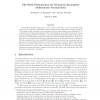Free Online Productivity Tools
i2Speak
i2Symbol
i2OCR
iTex2Img
iWeb2Print
iWeb2Shot
i2Type
iPdf2Split
iPdf2Merge
i2Bopomofo
i2Arabic
i2Style
i2Image
i2PDF
iLatex2Rtf
Sci2ools
MA
2010
Springer
2010
Springer
The Stein phenomenon for monotone incomplete multivariate normal data
We establish the Stein phenomenon in the context of two-step, monotone incomplete data drawn from Np+q(µ, Σ), a multivariate normal population with mean µ and covariance matrix Σ. On the basis of data consisting of n observations on all p+q characteristics and an additional N−n observations on the last q characteristics, where all observations are mutually independent, denote by bµ the maximum likelihood estimator of µ. We establish criteria which imply that shrinkage estimators of James-Stein type have lower risk than bµ under Euclidean quadratic loss. Further, we show that the corresponding positive-part estimators improve on their unrestricted counterparts. We derive results for the case in which Σ is block-diagonal, the loss function is quadratic and nonspherical, and the shrinkage estimator is constructed by means of a non-decreasing, differentiable function of a quadratic form in bµ. In the case of the problem of shrinking bµ to a vector whose components have a comm...
| Added | 29 Jan 2011 |
| Updated | 29 Jan 2011 |
| Type | Journal |
| Year | 2010 |
| Where | MA |
| Authors | Donald St. P. Richards, Tomoya Yamada |
Comments (0)

